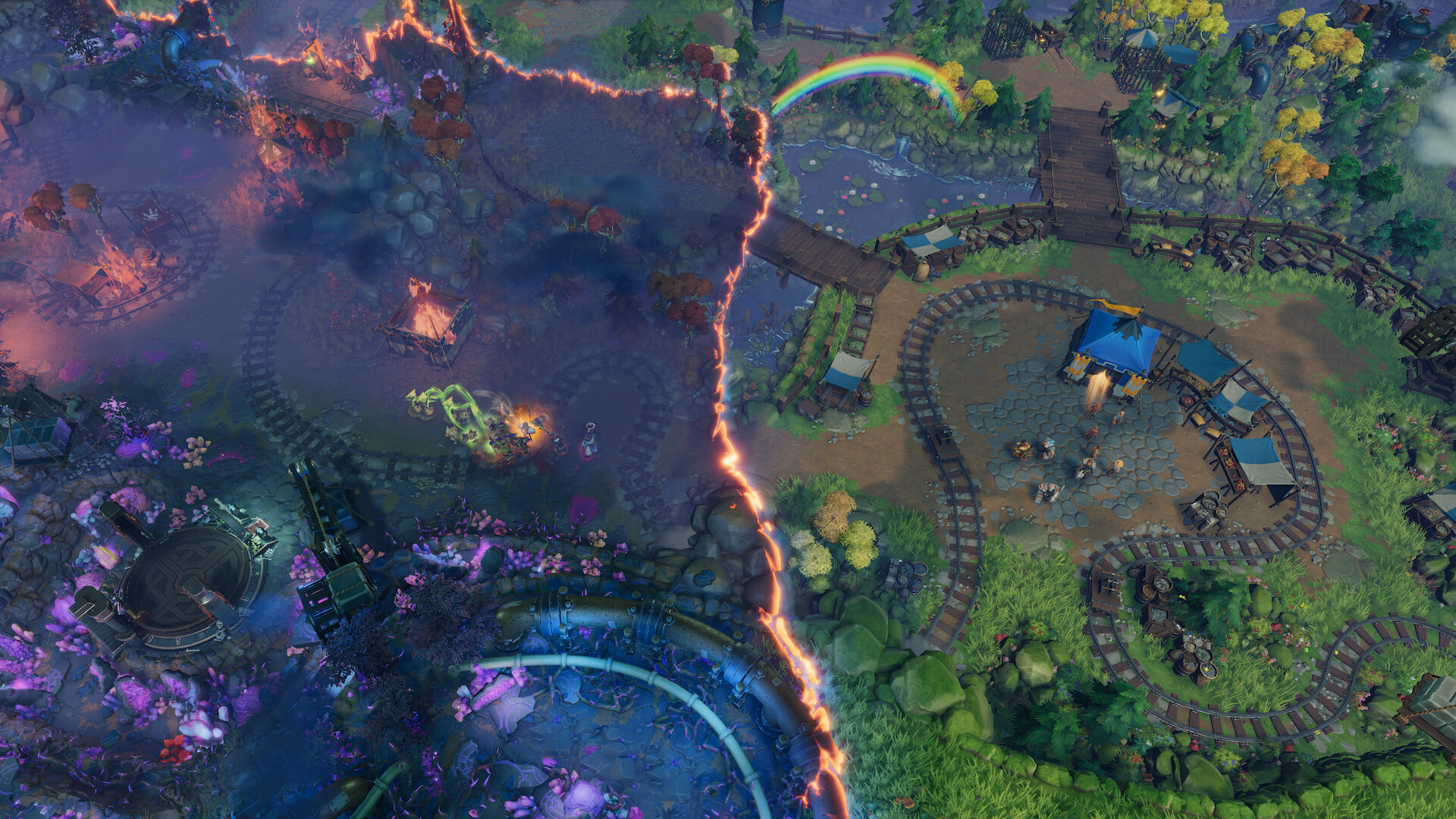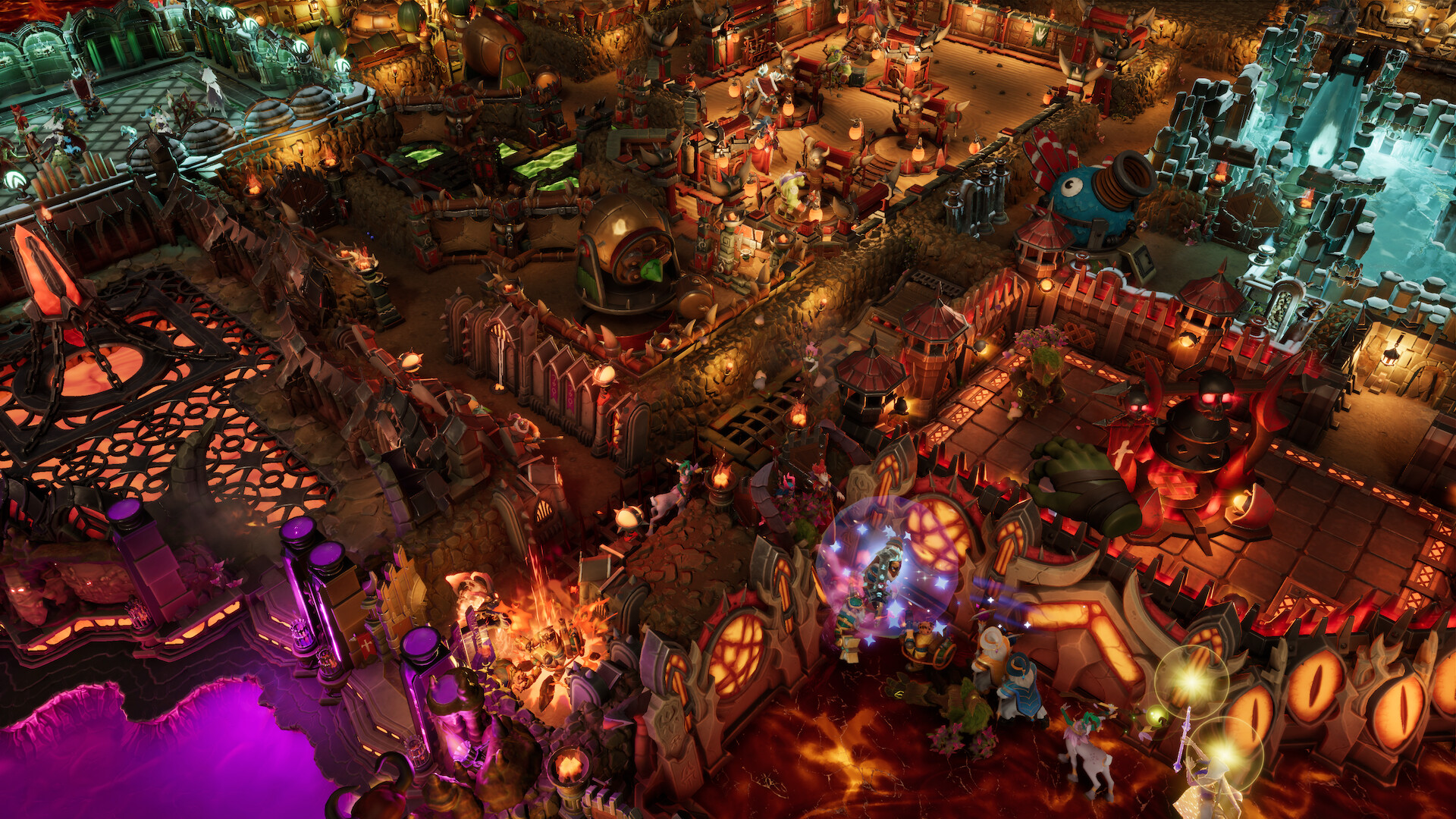There have been so many influential games over the decades that it’s easy to forget a few, like Dungeon Keeper. Developed by Bullfrog Productions in 1997 for MS-DOS, it offered a unique real-time strategy experience where the player effectively controlled the villain of a fantasy epic. With evil minions at the ready, you built a dungeon and defended it against heroes, using traps and recruiting powerful forces to your side. The dark humor was also an excellent touch and capably delivered by an unforgettable narrator.
Dungeon Keeper would inspire several titles throughout gaming’s history. There’s also Dungeons, Realmforge Studios’ franchise, which evolved from killing fully satisfied heroes (don’t ask, I don’t know) to a closer adaptation of Bullfrog’s formula. It mixes dungeon management and building while allowing you to take your forces to the surface to wreak havoc.
“While the story is fairly tongue-in-cheek and doesn’t mess around too much with fantasy tropes, the jokes range from grating to awful.”
Over eight years since Dungeons 2 and a whopping 26 years since the original Dungeon Keeper, we have Dungeons 4. It’s bigger, brighter and tries way too hard with the humor, but still an entertaining experience with enough new features.
The story sees Thalya, the Dark Elf, leading her forces against her stepbrother Tristan after murdering her father Tanos. As the Absolute Evil’s servant, Thalya boasts special abilities and can rally nearby units into a frenzy. After laying waste to her brother and seizing his magical gauntlet, she returns to the Dungeon Lord and inadvertently causes their demise. Taking up leadership of the evil armies is outside Thalya’s realm of expertise, and she’s swiftly captured. As the disembodied Evil Hand, it’s your job to rescue her, while going about and laying waste to the forces of good.
While the story is fairly tongue-in-cheek and doesn’t mess around too much with fantasy tropes, the jokes range from grating to awful. You’ll face jokes that mock the Marvel Cinematic Universe, microtransactions, heroic speeches and game design at a rapid clip, with no time to breathe and barely any set-up. It’s like the writers are throwing anything even somewhat relevant to the wall and see if it lands, which rarely happens.
The Narrator tries his best to roll with the punches and deliver them in a deadpan but sophisticated manner, but it all meshes together so horribly. It also doesn’t help that the in-game cinematic sequences (not the 2D cutscenes, which display some noticeable screen-tearing) are so awkwardly put together and executed. I’m not expecting triple-A production values, but these could have been handled better. It may sound overly harsh, but considering how prominent the story and dialogues are during the campaign, it’s a drag every time a new development occurs.
“While it’s possible to pick up and place units anywhere in your dungeon, smacking them around for an added boost, the overworld requires designating spots to attack.”
Gameplay-wise, the opening sequence starts with real-time strategy combat. You can select Thalya and different units with the directional pad on the Xbox controller or lasso them all at once. It can get chaotic, especially when thrown into the game for the first time. The good news is that past the annoying story set-up and unfunny circumstances – Thalya doing “the snap” with the Gauntlet of Finitude, har de har – the gameplay proceeds to the actual dungeon building.
You start with a Dungeon Heart and some minions who can mine out different sections underground, discovering Gold Veins and building Treasuries. Hoard enough, and you can spend Gold to hire Goblins, Orcs and Nagas or invest in further research. These units – and many more that pop up during gameplay, like Demons and the Undead – require different resources to sustain themselves. You need to build a Hideout where they can rest and Gobblers to eat.
Demons, on the other hand, don’t need rest but require a Vortex to regenerate if slain. It’s all standard RTS fare, and once you’ve made enough headway with research, you can start constructing Traps to impede any heroes that wander into your dungeon. A new addition to Dungeons 4 are Dwarves, who are also mining for Gold and will try to infiltrate your abode. Since they fall on the side of good, you get some Evil for slaying them, which can bolster your forces and technology.
After enough preparation, you send your forces to the overworld to take out the forces of good. While it’s possible to pick up and place units anywhere in your dungeon, smacking them around for an added boost, the overworld requires designating spots to attack. Sometimes, you encounter other units who are caged – free them, and they join your rampaging army, which further adds to the snowball (and helps get around unit caps).

“Whether you’re underground or in the overworld, environments and character models are vibrant, and the weather effects and lighting can be crisp.”
As you destroy more heroic buildings and conquer their armies, the landscape transforms and twists with a dark aura. Assail the required objectives, reap the Evil that comes with them (while building a Vault to store it) and then proceed to the next mission to repeat the process from scratch.
The mission design is decent but not spectacular, and initially familiarizes you with the mechanics while presenting a fun, if not altogether challenging experience, at least on Normal. Getting your bearings can be a little tough initially, especially when your units tire or hunger after a single battle and won’t attack an enemy structure unless plopped next to it. Nevertheless, while it seems lacking in strategic depth, it’s fun to watch your army wash over the enemy and obliterate them.
Maintaining that fervor while adjusting your dungeon, whether it’s traps that slow heroes down and push them into nearby lava, can feel oddly satisfying and somewhat addictive. Being able to rain down magic on unsuspecting enemies also doesn’t hurt and adds to the experience of being the Absolute Evil. The Narrator also doesn’t feel too overbearing throughout all this, though there’s an option to tone down the frequency of his commentary.
Co-op is supported for the campaign and Skirmish, and you can replay missions to unlock different Achievements. Outside of the cutscenes, the presentation is good. Whether you’re underground or in the overworld, environments and character models are vibrant, and the weather effects and lighting can be crisp.

“The series may never live up to Dungeon Keeper’s legacy, but it’s doing a good enough job of establishing its niche and continuously refining it.”
The downside is that performance slogs when multiple units are slaying out. It’s not unplayable, but definitely noticeable – thankfully, the combat speed is easy enough to manage even with these issues. The music can get repetitive, especially if your preferred genre isn’t “low-fi evil schemes to terrorize” but thankfully doesn’t grate (your mileage may vary).
Dungeons 4 doesn’t drastically overhaul the formula of its predecessors, instead focusing on refining and adding to it in fun ways. Realmforge knows its core gameplay loop and how to accentuate it in fun ways without overwhelming the player. Given the effort put into the story and its humor, it’s a shame that it feels so throwaway and the characters so bland.
Nevertheless, if you’re looking to build the dungeon of your dreams (or nightmares) and send evil armies out to cause chaos, Dungeons 4 may scratch that particular itch. The series may never live up to Dungeon Keeper’s legacy, but it’s doing a good enough job of establishing its niche and continuously refining it.
This game was reviewed on Xbox Series X.